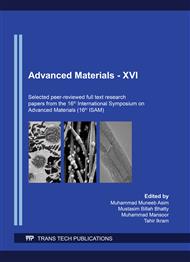[1]
V. M. Dehabadi, S. Ghorbanpour, and G. Azimi, Application of artificial neural network to predict Vickers microhardness of AA6061 friction stir welded sheets, J. Central South Univer. 23 (2016) 2146-2155.
DOI: 10.1007/s11771-016-3271-1
Google Scholar
[2]
L. Ceschini, I. Boromei, G. Minak, A. Morri, and F. Tarterini, Effect of friction stir welding on microstructure, tensile and fatigue properties of the AA7005/10 vol.% Al2O3p composite, Comp. Sci. Tech. 67 (2007) 605-615.
DOI: 10.1016/j.compscitech.2006.07.029
Google Scholar
[3]
Y. Mazaheri, F. Karimzadeh, and M. Enayati, A novel technique for development of A356/Al2O3 surface nanocomposite by friction stir processing, J. Mater. Proc. Tech. 211 (2011)1614-1619.
DOI: 10.1016/j.jmatprotec.2011.04.015
Google Scholar
[4]
A. Shafiei-Zarghani, S. Kashani-Bozorg, and A. Zarei-Hanzaki, Microstructures and mechanical properties of Al/Al2O3 surface nano-composite layer produced by friction stir processing, Mater. Sci. Eng. A, 500 (2009) 84-91.
DOI: 10.1016/j.msea.2008.09.064
Google Scholar
[5]
P. Cavaliere, E. Cerri, L. Marzoli, and J. Dos Santos, Friction stir welding of ceramic particle reinforced aluminium based metal matrix composites, Appl. Comp. Mater. 11 (2004) 247-258.
DOI: 10.1023/b:acma.0000035478.71092.ec
Google Scholar
[6]
W. Wang, Q.-y. Shi, P. Liu, H.-k. Li, and T. Li, A novel way to produce bulk SiCp reinforced aluminum metal matrix composites by friction stir processing, J. Marer. Proc. Tech. 209 (2009) 2099-2103.
DOI: 10.1016/j.jmatprotec.2008.05.001
Google Scholar
[7]
L. Marzoli, A. Strombeck, J. Dos Santos, C. Gambaro, and L. Volpone, Friction stir welding of an AA6061/Al2O3/20p reinforced alloy, Comp. Sci. Tech. 66 (2006) 363-371.
DOI: 10.1016/j.compscitech.2005.04.048
Google Scholar
[8]
M. Sharifitabar, A. Sarani, S. Khorshahian, and M. S. Afarani, Fabrication of 5052Al/Al2O3 nanoceramic particle reinforced composite via friction stir processing route, Mater. Des. 32 (2011) 4164-4172.
DOI: 10.1016/j.matdes.2011.04.048
Google Scholar
[9]
E. Mahmoud, K. Ikeuchi, and M. Takahashi, Fabrication of SiC particle reinforced composite on aluminium surface by friction stir processing, Sci. Tech.Weld. Join. 13 (2008) 607-618.
DOI: 10.1179/136217108x333327
Google Scholar
[10]
Y. Zhao, X. Huang, Q. Li, J. Huang, and K. Yan, Effect of friction stir processing with B 4 C particles on the microstructure and mechanical properties of 6061 aluminum alloy, Int. J. Adv, Manuf. Tech. 78 (2015) 1437-1443.
DOI: 10.1007/s00170-014-6748-9
Google Scholar
[11]
J. Pickens and M. Marietta, ASM handbook, volume 2: Properties and selection: Non-ferrous alloys and special-purpose materials, ASM Handbook Committee, vol. 4, pp.207-218, (1990).
DOI: 10.31399/asm.hb.v02.9781627081627
Google Scholar
[12]
M. Bahrami, N. Helmi, K. Dehghani, and M. K. B. Givi, Exploring the effects of SiC reinforcement incorporation on mechanical properties of friction stir welded 7075 aluminum alloy: fatigue life, impact energy, tensile strength, Mater. Sci. Eng. A. 595 (2014) 173-178.
DOI: 10.1016/j.msea.2013.11.068
Google Scholar
[13]
J. Zapata, J. Valderrama, E. Hoyos, and D. Lopez, Mechanical properties comparison of friction stir welding butt joints of AA1100 made in a conventional milling machine and a FSW machine, Dyna, 80 (2013) 115-123.
Google Scholar
[14]
P. Cavaliere, R. Nobile, F. Panella, and A. Squillace, Mechanical and microstructural behaviour of 2024–7075 aluminium alloy sheets joined by friction stir welding, Int. J. Mach. Tool Manf. 46 (2006) 588-594.
DOI: 10.1016/j.ijmachtools.2005.07.010
Google Scholar
[15]
K. Yang, W. Li, P. Niu, X. Yang, and Y. Xu, Cold sprayed AA2024/Al2O3 metal matrix composites improved by friction stir processing: Microstructure characterization, mechanical performance and strengthening mechanisms, J. Alloy. Comp. 736 (2018)115-123.
DOI: 10.1016/j.jallcom.2017.11.132
Google Scholar
[16]
A. Pirondi and L. Collini, Analysis of crack propagation resistance of Al–Al2O3 particulate-reinforced composite friction stir welded butt joints, Int. J. Fatg. 31 (2009) 111-121.
DOI: 10.1016/j.ijfatigue.2008.05.003
Google Scholar
[17]
F. Khodabakhshi, H. G. Yazdabadi, A. Kokabi, and A. Simchi, Friction stir welding of a P/M Al–Al2O3 nanocomposite: microstructure and mechanical properties, Mater. Sci. Eng. A, 585(2013) 222-232.
DOI: 10.1016/j.msea.2013.07.062
Google Scholar
[18]
W. Wang, Q. Shi, P. Liu, H. Li, T. Li, A novel way to produce bulk SiCp reinforced aluminum metal matrix composites by friction stir processing, J. Mater. Process. Technol. 209 (2009) 2099–2103.
DOI: 10.1016/j.jmatprotec.2008.05.001
Google Scholar
[19]
C.-H. Jeon et al., Material properties of graphene/aluminum metal matrix composites fabricated by friction stir processing, Int. J. Precis. Eng. Manuf., 15 (2014) 1235–1239.
DOI: 10.1007/s12541-014-0462-2
Google Scholar
[20]
Y. Zhao, X. Huang, Q. Li, J. Huang, and K. Yan, Effect of friction stir processing with B 4 C particles on the microstructure and mechanical properties of 6061 aluminum alloy, Int. J. Adv. Manuf. Technol., 78 (2015) 1437–1443.
DOI: 10.1007/s00170-014-6748-9
Google Scholar
[21]
V. Auradi, G.L. Rajesh, S.A. Kori, Processing of B4C Particulate Reinforced 6061Aluminum Matrix Composites by Melt Stirring Involving Two-step Addition, Proc. Mater. Sci., 6 (2014) 1068–1076.
DOI: 10.1016/j.mspro.2014.07.177
Google Scholar
[22]
N. Saheb, M. Shahzeb, A.S. Hakeem, Effect of Processing on Mechanically Alloyed and Spark Plasma Sintered Al-Al2O3 Nanocomposites. https://www.hindawi.com/journals/jnm/2015/609824/ (accessed Jun. 25, 2020).
DOI: 10.1155/2015/609824
Google Scholar
[23]
J. Fathi, P. Ebrahimzadeh, R. Farasati, R. Teimouri, Friction stir welding of aluminum 6061-T6 in presence of watercooling: Analyzing mechanical properties and residual stress distribution, Int. J. Lightweight Mater. Manuf. 2 (2019) 107–115.
DOI: 10.1016/j.ijlmm.2019.04.007
Google Scholar


